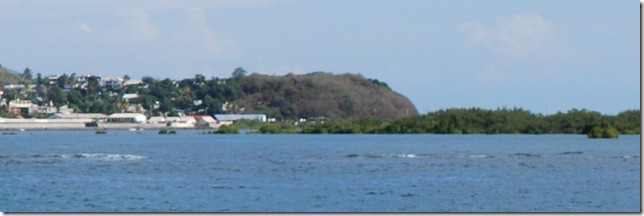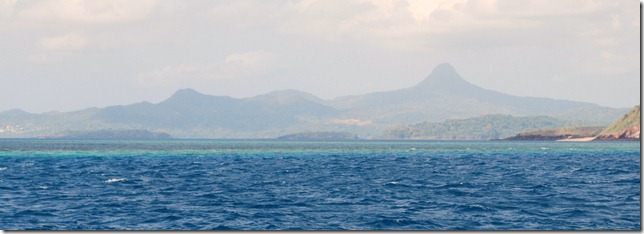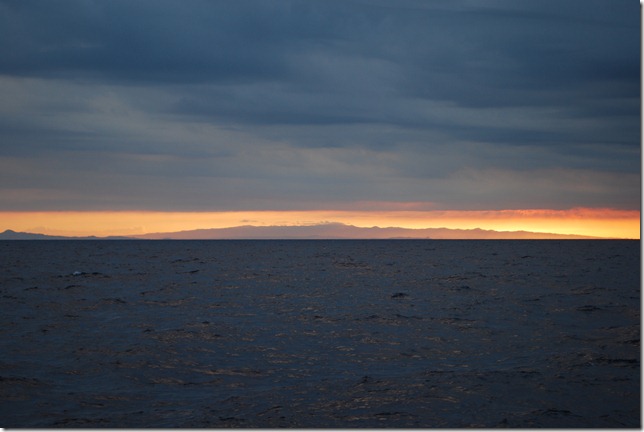So far, our stop in Mayotte has been productive, but we haven’t had much time for being tourists. Our first few days have been spent checking in, provisioning, knocking out the list of required boat repairs, updating the website, doing 5 weeks of laundry (not as much as you’d think with four of the weeks spent offshore), and jugging diesel and water to fill the tanks. The part for the rigging arrived at the airport on Friday, but won’t clear customs until today (Monday), so we’re planning to check out today, hope it fits, and leave on Tuesday morning. We’d love to stay longer and explore a bit, but we’re getting reminders that it’s time to be moving along. The first tropical disturbance and cyclone of the season have both occurred already. We were just in time to pass ahead of the tropical disturbance as we crossed the Indian Ocean, and the first cyclone was behind us as well, nearly hitting Cocos Keeling several weeks after we left. With the SW monsoon ending, the Somali pirates are moving south as well. Last week they captured a vessel en route from Tanzania to the Comoros, of which Mayotte is a disputed part. They’re still north of us, but the 200-mile buffer zone I’d planned to keep between us and any known Somali pirate attack is shrinking this year, made smaller by our stop in Mayotte, and really doesn’t seem like a lot once you’re here.
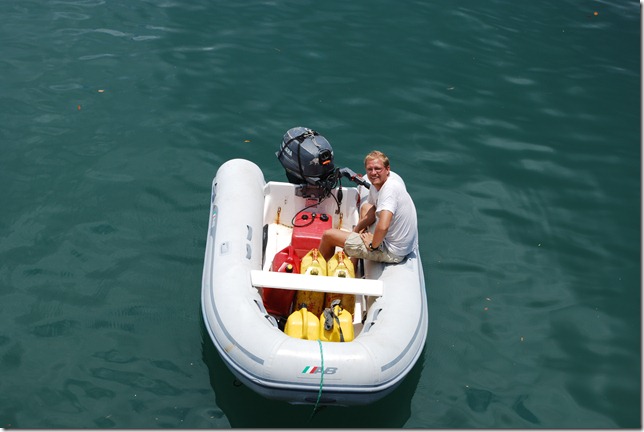 Bringing the diesel jugs in to the fuel station atop a rocky wharf
Bringing the diesel jugs in to the fuel station atop a rocky wharf
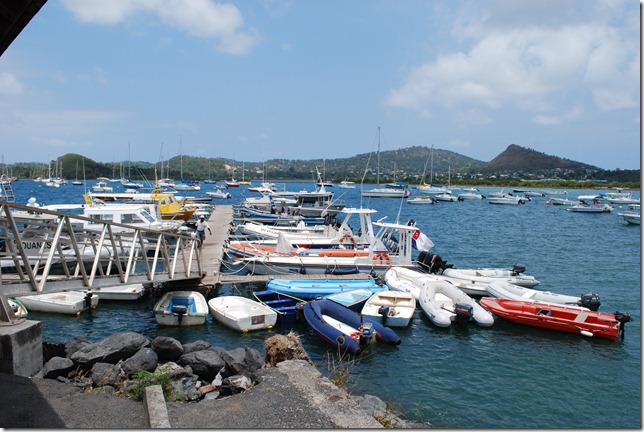 The finger pier used by dinghies wobbles so much that it seems like a water park gizmo meant to get you wet
The finger pier used by dinghies wobbles so much that it seems like a water park gizmo meant to get you wet
We’re getting a heavy rain this morning, which, along with the hot days of light wind is yet another sign of the changing monsoon. The Indian Ocean is different from the Atlantic and Pacific in that the North Indian Ocean is a “two-way” ocean subject to monsoons (from the Arabic word for fixed seasons). The prevailing wind direction in the North Indian Ocean changes from SW (May to October) to NE (November to March) annually, with the SW monsoon generally bringing more rain, and the transition between monsoons being a period of light winds and heavy rainstorms. The North Indian Ocean monsoons have been useful for sailors for centuries because they let you sail downwind across the ocean in both directions if you time your passage for the proper monsoon. Our current location in the northern part of the South Indian ocean at the end of the SW monsoon means that the trades in the area will be pushed south and replaced by the doldrums and squalls of the ITCZ in the next couple of months as it makes its yearly migration to the south accompanying the NE monsoon.
The anchorage here in Dzaoudzi is an interesting one. It’s about 50 feet deep, which is OK for anchoring, but you’d want to put out at least 200’ of chain, which means you’d need quite a distance between you and adjacent boats to avoid swinging into each other. Moorings have been laid instead, as there are a lot of French live-aboard boats here. Unfortunately, the moorings haven’t been planned very well and many leave boats within swinging distance of each other. Last night, with the very light winds and strange currents here, we bumped the boat next to us and saw other boats fending off as well. We were lucky to find an open mooring whose owner let us stay here for free. The other interesting thing about this mooring is the tidal lake beside it. At high tide, water from the lagoon flows into the lake, and at low tide the edge of the lake is like a waterfall, with rivers of water cascading into the anchorage. It makes a fun place for local kids to play, and the current is one of the reasons that the boats end up in odd orientations here. At the edge of the anchorage is the Blue Water Cruising Association of Mayotte. It would fall into the generally category of “yacht club” but is really more of a glorified boatyard serving the numerous French sailors that live aboard on moorings and on the hard. The bar is actually a shipping container with a service window cut in the side that is lifted with a sailing block and line in the morning and then dropped and locked at night. It is only approachable by dinghy during the upper half of the tide, but that timing has worked out well for us during our stay. Tide has been high right around shower time. We’ve enjoyed a couple of the refreshing cold water showers with a knob that you push to get about 5 seconds of water, just like the knobs on water-conserving sinks in public restrooms in the US.
 Local kids playing in the waterfalls created by the tidal lake
Local kids playing in the waterfalls created by the tidal lake
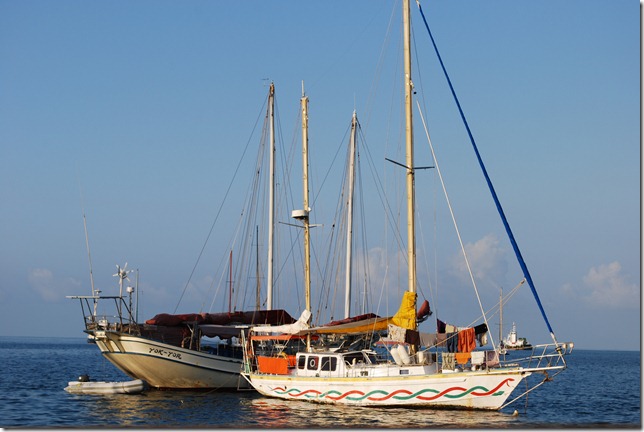 Two boats doing the Dzaoudzi light wind tango
Two boats doing the Dzaoudzi light wind tango
We have managed to avail ourselves of one of the French luxuries that Wes introduced me to – bread, cheese & wine. The French territories always have fresh baguettes, and the boulangeries here make an excellent assortment of fresh bread daily. The cheese selection in the supermarket, which is usually very limited in remote places, would rival an upscale US grocery store, and the wine selection is unusually diverse and cheap, with numerous French and South African selections. We were snacking on bread and cheese at the “yacht club” yesterday evening when I commented on the good cheese to one of the friendly Frenchman who’d come over to visit with us. He took a look at our selection and grunted with a disinterested air, “Hmmm, cooking cheese.” Ahh the French. We’d forgotten about the unique and numerous mannerisms they have. I can’t really think of a parallel in the US for the characteristic French hand gestures and facial expressions that often accompany or substitute for common descriptive expressions.
The combined cyclone risk and virtual guarantee of a southerly ‘buster’ or two that will make for dangerous wave states when it opposes the strong southerly current may make the passage from here to South Africa one of our tougher ones. If the weather cooperates, we’re planning to move south as quickly as possible until we get to the south part of the Mozambique channel where the busters are common. From there to South Africa, we’ll try to move when the winds are good and duck into an anchorage in Mozambique when the winds come from the south. Once we get closer to Mozambique, we should be in the south-setting Mozambique current while we’re moving, which will give us a boost.
Now if only the downpour would stop so we can run our final errands without getting soaked…
Approaching Mayotte was pretty exciting. For the first time in 24 night watches, I had no trouble staying awake until 3 a.m. The wind freshened quite a bit, and in order to avoid putting strain on the rigging, I furled the jib a few times until we were going 4+ knots with just a bit of sail. I could see the glow of civilization on the horizon in the otherwise black night from about 30 miles out, which was quite different from the single point of light that could be seen from Madagascar at night. Then it was time for one last short night of sleep.
By the time I arose, Dallas had already navigated through the large pass into the lagoon. We agreed that the landscape is reminiscent of the Society Islands in French Polynesia. They seem to fit Earl Hinz’ (author of “Landfalls of the Pacific”) definition of an “almost atoll” – the volcanic islands have started to recede into the sea, leaving just the peaks exposed in the midst of the lagoon. Surrounding the lagoon is limestone reef that emerged from the earth’s crust as the volcanoes sank. Here in Mayotte there is one main island (Grand Terre), a smaller one where we are moored (Petite Terre), and a number of very small, uninhabited islands, some of which have beautiful white sand beaches.
The mishaps began when we approached the mooring field. I generally work the bow while Dallas is at the helm, and I had the bridle in place in preparation to anchor. However, the area turned out to be too deep and full of boats for anchoring, so I quickly located our mooring line in the bottom of the sail locker and replaced the bridle set-up. Dallas motored us up to the mooring into the strong wind and swell. I got hold of the buoy with the boat hook but didn’t drag it up and get our line through it fast enough, and before I knew it, the mooring was under the boat with the boat hook attached. The boat hook is pretty important to my work at the bow, so I hopped in the water to retrieve it, swam back to the transom to get on board, and returned to the bow for round two.
This time I was able to pull up the buoy and get our line through, but I put it through a loop of weak rope instead of the thick and sturdy one underneath the large but very heavy buoy. Dallas told me we needed to try again, but I couldn’t get our line free. It was stuck on the buoy. I was afraid the free end of our line was going to end up wrapped around our propeller, which would not make for a good day, so I hopped in the water again! Once in the water, getting the line free was easy, but getting back to the boat in the midst of the strong current was not. Despite the communication problems during this incident (the noise of the wind and the need for quick action made it tough), Dallas decided he wanted to retrieve me and spun the boat around to pick me up. Eventually I made it back on board, and we decided to give it a go again (what choice did we have?!). This time I took the helm, we chose a different buoy, and Dallas was able to pull it up and get us secured to it. Third time’s a charm.
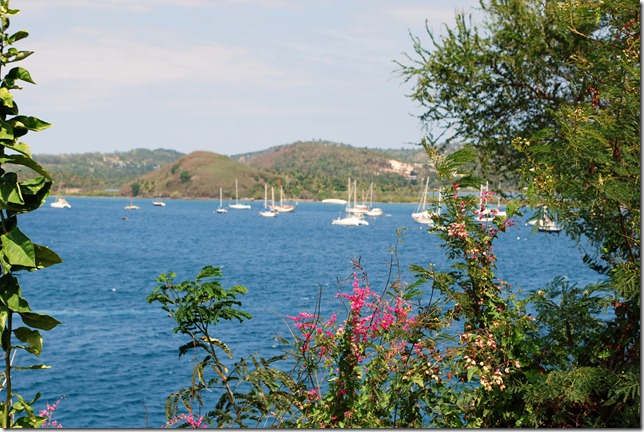 A pretty picture once safely secured on the mooring
A pretty picture once safely secured on the mooring
Speaking of which, I ended up in the water for yet a third time yesterday. It happened that evening after we had returned from taking a walking tour around the island and enjoying some cold beer and pizza. (I guess beer took precedence over salad, although we found a pretty good market and had some salad that evening on the boat.) We had read in other cruisers’ blogs that, at least in 2008, there was quite a bit of crime in Mayotte, and dinghies/outboard engines were commonly stolen. The manager of the yacht club told us it hadn’t happened for a while but suggested that we not stow our outboard behind the boat just in case. We agreed that there’s no point in taking chances with such vital gear, so for the first time ever, we decided to bring it inside the boat at night. With our 15-horsepower, 4-stroke outboard, this is not the easiest of tasks – at least not the first time. We hoisted it up without too much trouble, but in doing so, the cover came off and started floating away. Dallas, who was holding the outboard in place on the boat, shouted, “get it!” So I found myself in the murky water once again. I went through as many clothes yesterday as I did in one week offshore!
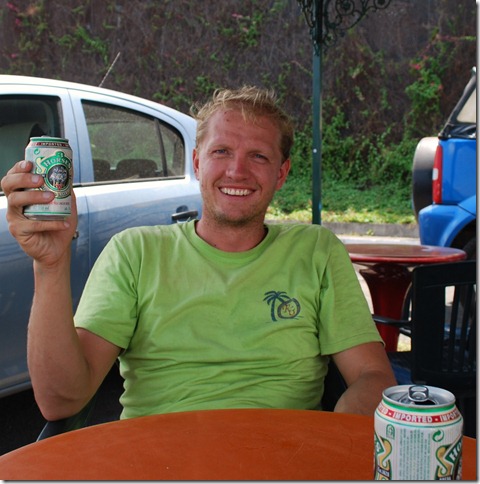 Civilization has its merits such as Three Horses Beer (called “Tay-Hash-Bay”, French for T.H.B.)
Civilization has its merits such as Three Horses Beer (called “Tay-Hash-Bay”, French for T.H.B.)
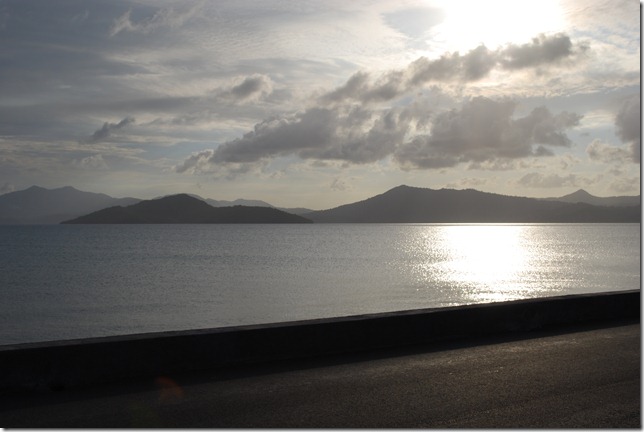 No shortage of natural beauty here either
No shortage of natural beauty here either
Despite the mishaps and potential for crime, it has been a most welcome change to be in the vicinity of land, and a new continent at that! The French presence is very strong here, with French gendarmes (police), French Foreign Legion, and expats visible everywhere we’ve been, but the Mayotte people are still very much African. They are well dressed in colorful sarongs (women) and headwear (men and women) and seem to carry themselves with pride. Some of the women paint their face with an off-white makeup, and I have yet to find out why – just having simple conversations in French has been pretty challenging so far, so we’ll see how it goes!
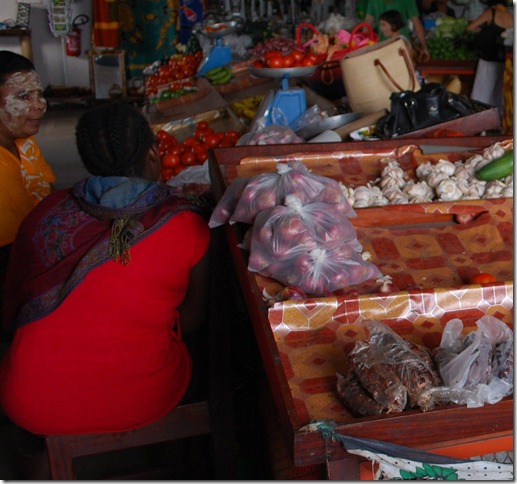 See the face painting – mais pourquoi?!
See the face painting – mais pourquoi?!
It has been pretty full on since we’ve been here – clearing in, getting our bearings, provisioning, taking advantage of internet, etc., but we are going to enjoy some French wine and cheese and a good night’s sleep tonight.
Lat: 12 56.143′ S
Lon: 46 45.511′ E
As Lauren mentioned, sailing by north coast of Madagascar without stopping was tough. Seeing the names of the places we’d read about so close to us on the chartplotter, wanting to meet and trade with the locals, and craving a good night’s sleep left me indecisive until the last minute, but ultimately we decided to sail straight on to Mayotte. At this point, getting out of the cyclone region is our top priority.
Because there are reported to be uncharted reefs on the banks near Madagascar, we’ve kept a course that stays clear of both the near-shore and offshore banks, where depths of over 10,000 feet suddenly rise to 100′ or less. It’s not long after rounding the cape that the tradewinds change direction and then begin to disappear completely, giving way to the light and variable winds that dominate the northeastern part of the Mozambique channel. We also traded the helpful west-setting south equatorial current for a north-setting current that has slowed us down as well. All together, it’s meant that “good” speeds with our damaged rig are now around 3-3.5 knots, making our journey to Mayotte a slow but steady one.
Sunrise yesterday found us still making our way south along the western coastal bank. We were ghosting along at just over 2 knots when the thin strip of eastern sky above the mountains and below the clouds slowly became a glowing, fiery shade of red, casting the mountains as dark silhouettes. The radiant crescent moon hanging above the coastline was still shining brightly as the sky above the clouds began to take on pale shades of blue, grey, and white. Within a few hours we’d dropped below 2 knots under sail, with the wind swinging well forward of the beam. The clear dawn had given way to a hot and hazy morning. It was already hot enough when Lauren woke up that we both climbed down the port swim ladder enjoy a dip in the clear, cool water before starting the engine. “Instant gratification,” was Lauren’s response to immediately feeling cool and refreshed. By noon it was 94 degrees in the salon, about 13 degrees hotter than it was the day before at noon when we were rounding the cape.
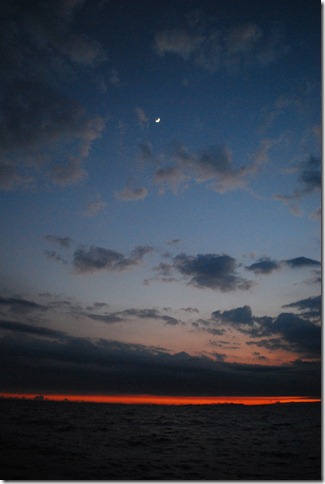 Crescent moon hanging over the fiery red skyline
Crescent moon hanging over the fiery red skyline
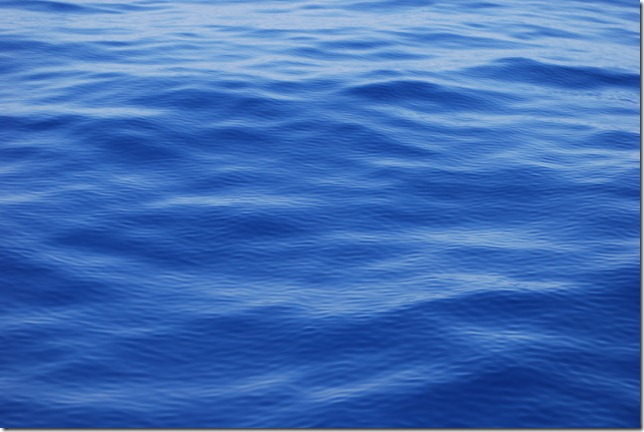 It was as calm as a lake when we jumped in to cool off
It was as calm as a lake when we jumped in to cool off
After an uneventful afternoon of motoring, we got a treat at sunset when I grew a little impatient, changing course early so that we passed just over the southern tip of the Castor Bank as we made for Mayotte, 145 nm due west. As we passed over the bank’s edge, with the sun a glowing ball low in the sky, dolphins started swimming toward us from several directions. At first they seemed docile, and even a little boring, but before long they were breaking the water regularly, while farther away from the boat, several of them made acrobatic leaps and spins, propelling themselves completely clear of the water. In typical fashion, 10 or so swam ahead of and between the bows, playfully jostling each other without ever touching and coming up in groups of two to four for a quick breath before darting back into small, tight, but dynamic formations. It’s been a while since we’ve seen a dolphin show like that, and we thoroughly enjoyed both the show and the timing.
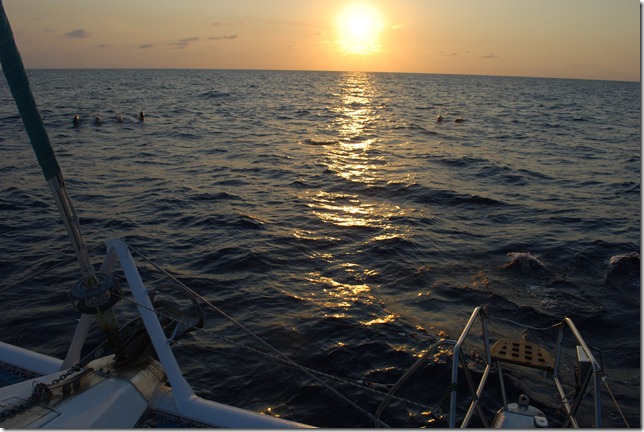 Six dolphins breaking the water as they swim toward us
Six dolphins breaking the water as they swim toward us
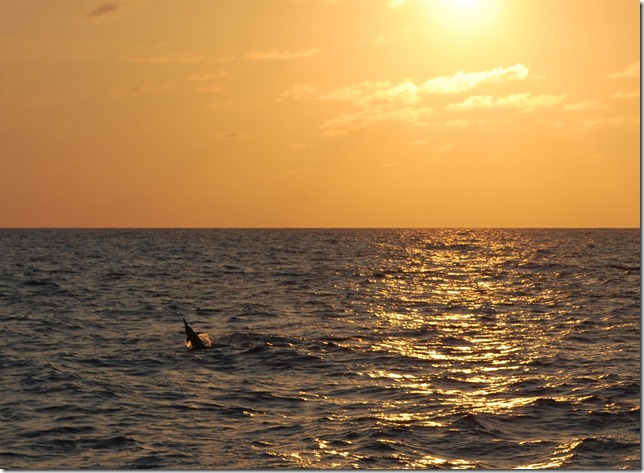 The beginning of a spinning jump
The beginning of a spinning jump
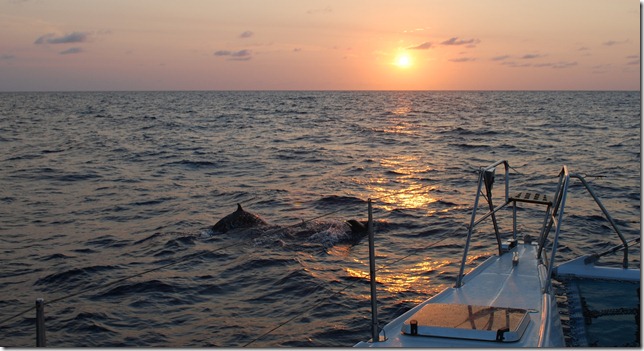 I’m not sure who covered more ground today, but they were probably having more fun
I’m not sure who covered more ground today, but they were probably having more fun
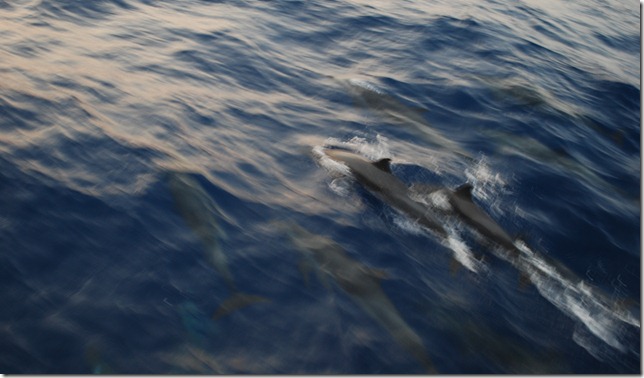 I counted 11 dolphins in the full-size version of this pic
I counted 11 dolphins in the full-size version of this pic
In the twilight, we noticed that the wind had changed again, so we unfurled the jib, this time on a starboard tack as a NNE wind let us sail the rhumb line toward Mayotte. With 90 miles left to go this morning, it’s looking like tomorrow will be the day we finally drop the hook and end our longest passage to date.
Lat: 12 08.785′ S
Long: 48 42.587′ E
Land ho! Dallas was able to see the landscape of Madagascar as soon as the sun came up this morning, at which point we were about 25 miles offshore. I crawled out of bed after 4 1/2 hours of sleep to get a look for myself. The landscape is different than any we have seen before from sea. There are several small but steep mountains with pointy peaks with rolling hills in between. Unlike the lush volcanic islands that we are used to seeing, the land here fits with my vision of the serengetti with its yellow, brown, and red tones. Apparently Madagascar was quite a bit greener in the recent past but was deforested by the residents. It’s hard to imagine.
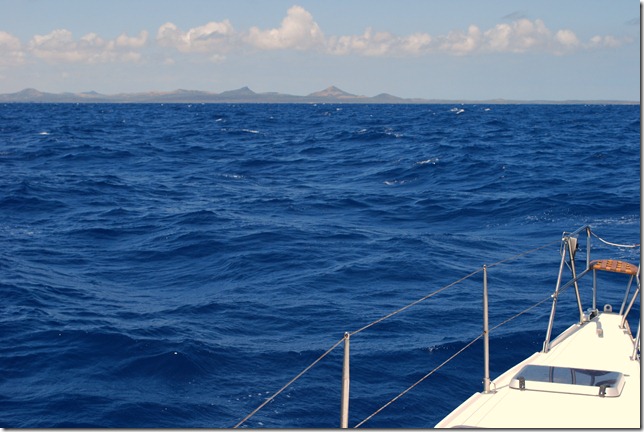 First sight of land in quite some time
First sight of land in quite some time
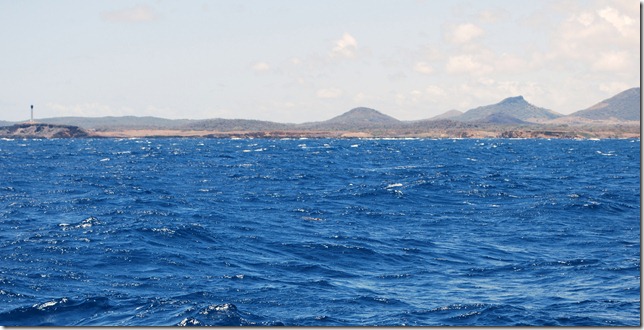
Madagascar was calling my name
After exactly 3 weeks at sea, it was exciting to be in the proximity of land. When approaching a new place, it is always interesting to see the landscape unfold, and there are usually fishing vessels around. Today we haven’t seen a single boat, but a highlight for me was spotting two sea turtles not far from the boat.
With the landscape of Madagascar becoming more and more distant behind us, it would be inaccurate to say that we’ve “made landfall”. It is rewarding to know that we’ve crossed the Indian Ocean but a bit, well, anticlimactic. This is the first time we’ve approached land after an offshore passage without dropping the hook and exploring the place, but we have to cut corners somewhere in order to get out of the way of cyclones ASAP. Up until just a few hours ago, Dallas was still toying with the possibility of spending a few days in Nosy Be on the northwest coast of Madagascar, but after speaking to a rigger in South Africa who has the part we need, it was confirmed that shipping to Mayotte is more reliable, so to Mayotte we will go. Our rigging toggle should be there when we arrive.
Mayotte is only about a two day sail (or motorsail, more likely) from here. I’m sure we can hold out that long. It should be an interesting spot — as a French territory, it is supposed to represent a mix of French and African cultures with a bit of Arab thrown in. My French must be awfully rusty by now, but I know enough to order some croissants and red wine!
Apart from being farther away, my biggest reservation about choosing Mayotte over Madagascar is that, Mayotte being French, it doesn’t represent Africa per se. For example, the wages and standard of living in Mayotte are comparable to those of Europe, whereas Madagascar is one of the poorest countries in the world. However, we should have a chance to see the impoverished side of Africa and distribute our balls, clothes, etc. while we are coastal hopping along Mozambique.
We pulled in a barracuda about an hour ago, so I’m going to cook up a small piece for dinner. I would like to have a big piece, but since we caught it in an area where there are reefs, there’s a chance that it might have ciguatera toxins, so I’m going to sample a bit and see what happens as suggested by our fishing handbook. Symptoms (in minor cases) include tingling lips, nausea, and vomiting, so hopefully my craving for fresh fish won’t come back to bite me!


